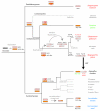Evidence for horizontal transfer of a secondary metabolite gene cluster between fungi
- PMID: 18218086
- PMCID: PMC2395248
- DOI: 10.1186/gb-2008-9-1-r18
Evidence for horizontal transfer of a secondary metabolite gene cluster between fungi
Abstract
Background: Filamentous fungi synthesize many secondary metabolites and are rich in genes encoding proteins involved in their biosynthesis. Genes from the same pathway are often clustered and co-expressed in particular conditions. Such secondary metabolism gene clusters evolve rapidly through multiple rearrangements, duplications and losses. It has long been suspected that clusters can be transferred horizontally between species, but few concrete examples have been described so far.
Results: In the rice blast fungus Magnaporthe grisea, the avirulence gene ACE1 that codes for a hybrid polyketide synthase-nonribosomal peptide synthetase (PKS-NRPS) belongs to a cluster of 15 genes involved in secondary metabolism. Additional related clusters were detected in the ascomycetes Chaetomium globosum, Stagonospora nodorum and Aspergillus clavatus. Gene-by-gene phylogenetic analysis showed that in C. globosum and M. grisea, the evolution of these ACE1-like clusters is characterized by successive complex duplication events including tandem duplication within the M. grisea cluster. The phylogenetic trees also present evidence that at least five of the six genes in the homologous ACE1 gene cluster in A. clavatus originated by horizontal transfer from a donor closely related to M. grisea.
Conclusion: The ACE1 cluster originally identified in M. grisea is shared by only few fungal species. Its sporadic distribution within euascomycetes is mainly explained by multiple events of duplication and losses. However, because A. clavatus contains an ACE1 cluster of only six genes, we propose that horizontal transfer from a relative of M. grisea into an ancestor of A. clavatus provides a much simpler explanation of the observed data than the alternative of multiple events of duplication and losses of parts of the cluster.
Figures



References
Publication types
MeSH terms
Substances
LinkOut - more resources
Full Text Sources
Medical
Research Materials
Miscellaneous

